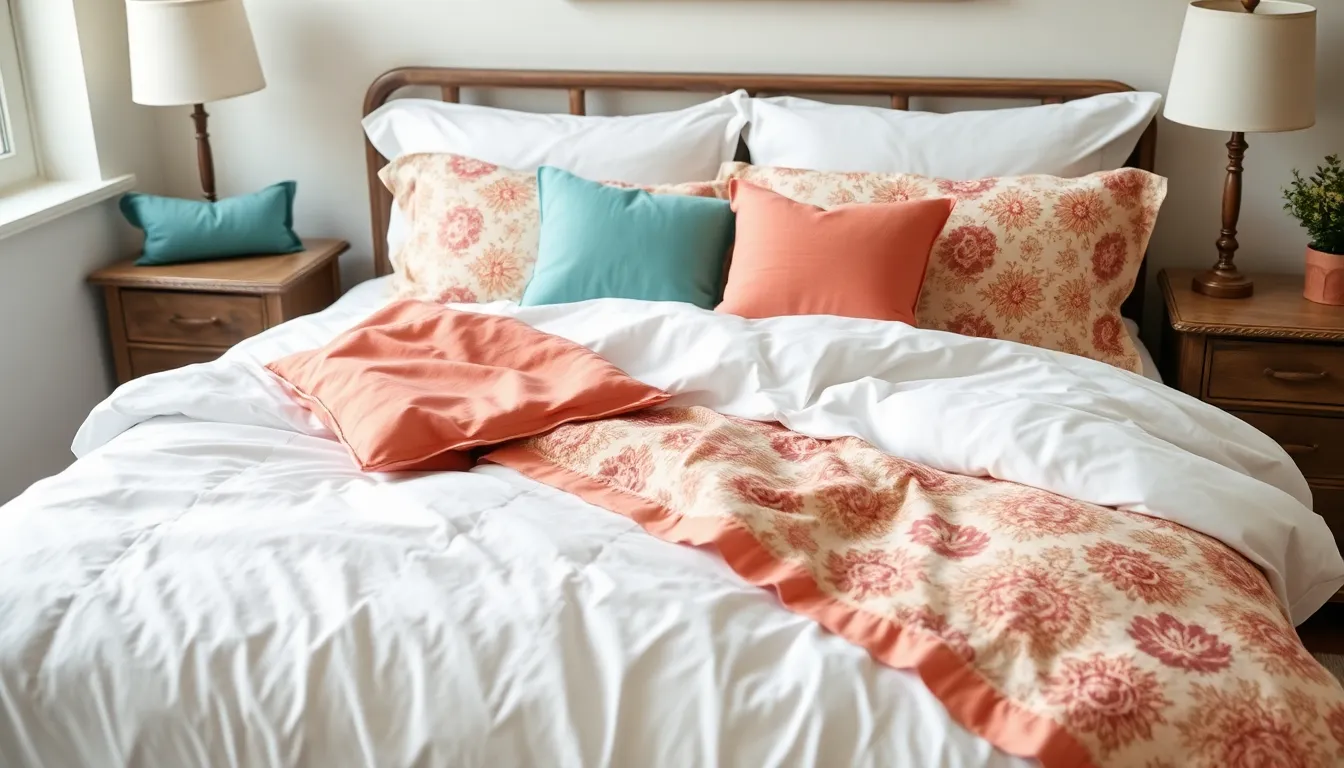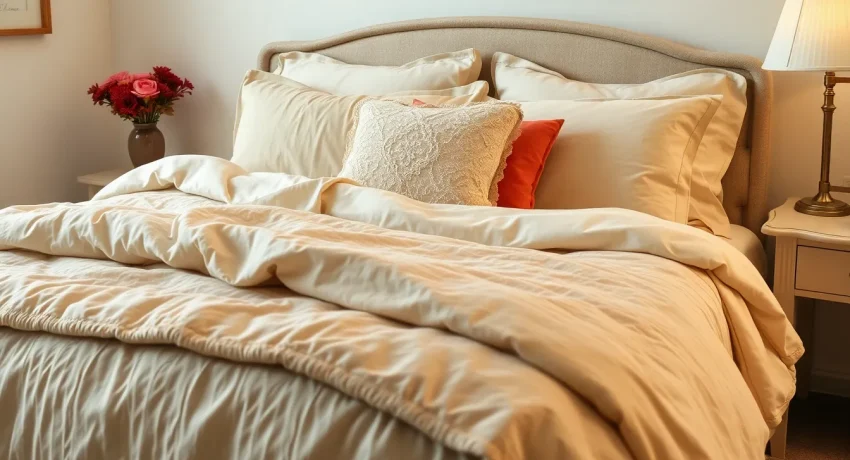Transforming a bedroom into a cozy sanctuary starts with the right linens. Think of bedroom linens as the unsung heroes of your sleep routine. They’re not just fabric; they’re the plush embrace that lulls you into dreamland after a long day. Who wouldn’t want to dive into a bed that feels like a cloud?
Choosing the perfect sheets, blankets, and pillowcases can be as thrilling as finding the last cookie in the jar. With a plethora of colors, textures, and materials, it’s easy to get lost in the world of bedroom linens. Whether you’re a cotton connoisseur or a satin seeker, the right choices can elevate your sleep experience from “meh” to “ahh.” Let’s explore how to dress your bed in style and comfort, turning your nightly retreat into a five-star experience without the hefty price tag.
Table of Contents
ToggleOverview of Bedroom Linens
Bedroom linens play a crucial role in defining the overall atmosphere of a sleeping space. They encompass various elements, including bed sheets, pillowcases, comforters, and duvet covers. Each component significantly affects comfort and style, contributing to a cozy retreat.
Selecting the right materials is vital for enhancing the sleep experience. Cotton, for instance, offers breathability and softness, making it a popular choice. Linen ensures durability and a relaxed texture, ideal for warmer climates. Microfiber provides a smooth feel at a lower cost, appealing to budget-conscious consumers.
Color and texture also influence the aesthetic appeal of a bedroom. Crisp white linens promote a clean look and create a serene environment. In contrast, vibrant patterns and colors can add personality and warmth. Layering different textures can enhance depth and visual interest, making the bed more inviting.
Maintaining bedroom linens involves regular washing and careful handling. Washing linens weekly not only promotes hygiene but also prolongs their lifespan. Using mild detergents prevents fabric damage while maintaining color integrity. Proper folding and storage can keep linens fresh and wrinkle-free when not in use.
Understanding thread count is essential when evaluating quality. A higher thread count typically indicates softer and more durable sheets, with counts ranging between 200 to 800 being ideal for most consumers. However, other factors like material and weave also contribute to the overall feel and performance of the linens.
Transforming a bedroom becomes achievable through attention to these aspects of linens. Careful selection enhances both comfort and style, making nightly rituals more enjoyable and restful. With the right choices, any bedroom can become a luxurious sanctuary for sleep.
Types of Bedroom Linens

Bedroom linens encompass various items essential for comfort and style. Understanding these types helps in making informed choices.
Bed Sheets
Bed sheets serve as the foundation for a cozy sleep environment. Common materials include cotton, linen, and microfiber. Cotton bed sheets, known for their breathability, enhance comfort throughout the night. Linen options offer durability and a relaxed aesthetic, perfect for warmer climates. Microfiber sheets provide an affordable alternative with a soft feel. Thread count matters; higher counts generally translate to softer sheets. Consider the weave style, such as percale for crispness and sateen for silkiness, to suit personal preferences.
Pillowcases
Pillowcases play a crucial role in enhancing sleep quality. They come in various materials, each offering unique benefits. Cotton pillowcases promote airflow and moisture-wicking properties, making them ideal for hot sleepers. Satin pillowcases reduce friction, benefiting hair and skin health. Choose sizes that fit standard, queen, or king pillows properly to avoid discomfort during sleep. Patterns and colors can complement the bedroom decor, providing both functional and aesthetic value.
Duvet Covers
Duvet covers protect comforters while adding a decorative touch to the bedroom. Options range from cotton to polyester blends, offering diverse choices based on needs. Cotton duvet covers provide breathability and softness, while synthetic materials can be easy to clean and maintain. When selecting duvet covers, consider the closure style—buttons, zippers, or ties—all of which offer varying degrees of convenience. Aesthetic factors also play a significant role, with patterns and colors able to transform the overall look of the space.
Materials Used in Bedroom Linens
Selecting the right materials for bedroom linens enhances comfort and functionality. Different fabrics offer various benefits, catering to diverse preferences.
Cotton
Cotton dominates the bedroom linen market due to its breathability and softness. Commonly used in sheets, pillowcases, and duvet covers, it offers a comfortable sleeping experience. Organic cotton provides an eco-friendly option without compromising quality. For optimal comfort, choose sheets with a thread count between 200 and 400. Fabrics woven with percale or sateen finishes provide varied textures, suiting different tactile preferences.
Linen
Linen stands out for its durability and natural moisture-wicking properties. Offering a relaxed aesthetic, linen becomes softer with each wash, making it ideal for cozy bedding. This breathable fabric regulates temperature, keeping sleepers comfortable throughout the night. Often favored in warmer climates, linen’s unique texture adds visual interest to bedroom decor. A slight irregularity in weave enhances its charm, setting it apart from smoother materials.
Polyester
Polyester serves as a popular, budget-friendly alternative to natural fabrics. Its resistance to wrinkles and fading ensures longevity in bedroom linens. Often blended with cotton, polyester improves durability while maintaining affordability. This fabric dries quickly, making it practical for frequent laundering. Vibrant prints and designs on polyester coverings can elevate the overall style of a bedroom, adding a splash of personality.
Choosing the Right Bedroom Linens
Selecting bedroom linens involves careful consideration to enhance comfort and aesthetic appeal. A few factors significantly influence the decision-making process.
Thread Count Considerations
Thread count represents the number of threads woven in a square inch of fabric. Higher counts, typically ranging from 200 to 400, lead to softer and more durable sheets. Opt for 100% cotton sheets to enjoy breathability and comfort. Consider percale and sateen weaves; each provides distinct qualities for varying preferences. While a thread count above 400 can offer luxury, it doesn’t always guarantee better quality. Balance is key, as both material type and weaving style affect the overall feel.
Seasonal Preferences
Seasonal changes dictate preferences for bedroom linens. In warmer months, opt for lightweight materials like linen or cotton to promote airflow. These fabrics help regulate body temperature, ensuring a comfortable sleep. During colder seasons, thicker materials such as flannel or satin provide warmth and coziness. Color choices also shift with seasons; lighter shades may evoke a fresh spring feel, while deeper hues can create a cozy winter atmosphere. Awareness of these seasonal variations enhances the overall sleep experience.
Care and Maintenance of Bedroom Linens
Proper care and maintenance extend the lifespan and maintain the beauty of bedroom linens. Implementing simple techniques ensures comfort and freshness throughout use.
Washing Tips
Regular washing prevents the buildup of dust, allergens, and odors, promoting a clean sleeping environment. Use cold or warm water for most linen materials, while hot water is suitable for cotton when sanitizing. Opt for gentle cycle settings to reduce wear. For detergent, choose a mild option to avoid deterioration of fibers. Avoid fabric softeners, as they can reduce breathability. Wash bed sheets, pillowcases, and duvet covers separately to prevent entanglement and damage. Aim to wash linens every 1-2 weeks, adjusting frequency based on personal hygiene and seasonal considerations.
Storage Recommendations
Proper storage helps maintain the quality and longevity of linens when not in use. First, ensure that linens are completely dry before storing to prevent mold and mildew. Consider folding sheets neatly and stacking them in a cool, dry place, avoiding damp environments. Use breathable cotton or linen storage bags instead of plastic to allow airflow. Label storage containers to simplify access when needed. Keep linens organized by set and type to streamline the retrieval process. Regularly inspect linens for signs of wear or pests to address issues promptly.
Choosing the right bedroom linens is essential for creating a restful and inviting space. With a variety of materials colors and textures available it’s easy to find options that suit personal preferences and enhance the overall aesthetic. Investing in quality linens not only elevates comfort but also contributes to a more enjoyable sleep experience.
By understanding the benefits of different fabrics and staying mindful of seasonal needs individuals can transform their bedrooms into luxurious retreats. Proper care and maintenance further ensure that these linens remain beautiful and functional for years to come. Embracing the right choices in bedroom linens can make a significant difference in achieving a cozy and stylish sanctuary.




